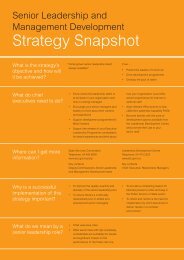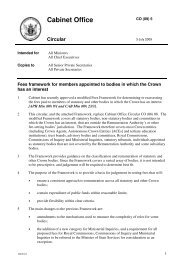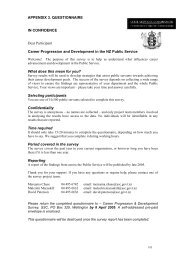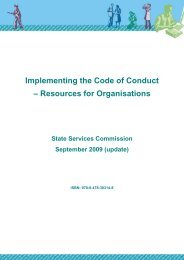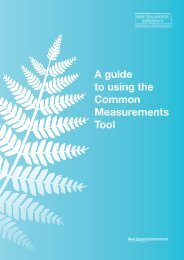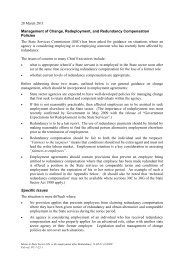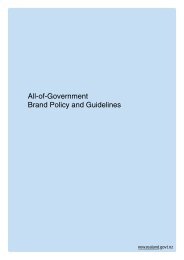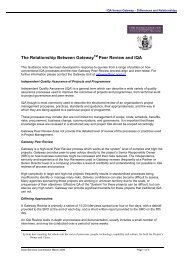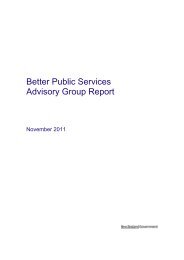NZ Report / Proposal Template - State Services Commission
NZ Report / Proposal Template - State Services Commission
NZ Report / Proposal Template - State Services Commission
You also want an ePaper? Increase the reach of your titles
YUMPU automatically turns print PDFs into web optimized ePapers that Google loves.
Department has in place processes for reviewing the cost estimates prepared for each of<br />
the projects. This has involved use of external professional/expert advisers.<br />
Uncertainties With the Earlier Cost Estimates<br />
4.8 The information presented to Cabinet in December 2005 was intended to provide a<br />
link back to earlier cost estimates provided in the context of Budget 05 (and before that,<br />
Budget 04). It is important to appreciate that the earlier estimates were indicative only.<br />
4.9 The Budget 05 (and Budget 04) estimates were based on high-level assessments<br />
of construction cost. At the time of the earlier estimates, detailed designs had yet to be<br />
completed. Accordingly, the earlier estimates had high degrees of risk and uncertainty<br />
attaching to them. The initial estimates were also based on a traditional quantity surveyor<br />
approach to cost estimation which involves assessing the scope of work (e.g. m 2 of floor<br />
space) and attaching a generic rate ($/m 2 ). In contrast, the latest cost estimates reflect<br />
the outcome of applying the CWA methodology. This involves a detailed line by line<br />
assessment of all inputs and processes involved in constructing the facilities. This is a<br />
fundamentally different approach to estimating cost and, accordingly, there is an element<br />
of attempting to compare apples with oranges when comparing latest with earlier<br />
estimates.<br />
Market Influences<br />
4.10 Under the heading of market influences, the Department has apportioned the cost<br />
increases under four headings; escalation, labour rates and location, margins and<br />
overhead and on-site construction costs.<br />
Escalation<br />
4.11 The construction market has been heated over the time period during which Spring<br />
Hill and Otago have been being constructed. Estimated construction costs have been<br />
escalated with reference to the Capital Goods Price Index for Non-Residential Building<br />
(CGPI-NRB). Forecasts of the CGPI-NRB are prepared by the New Zealand Institute of<br />
Economic Research (<strong>NZ</strong>IER) and, as far as we are aware, the <strong>NZ</strong>IER forecasts are the<br />
only ones that are widely available and published quarterly. The CGPI-NRB is produced<br />
by Statistics New Zealand (S<strong>NZ</strong>) and is based on a basket of “model buildings”<br />
determined by S<strong>NZ</strong>. The prices associated with each model building are updated by S<strong>NZ</strong><br />
from the New Zealand Building Economist (<strong>NZ</strong>BE) publication.<br />
4.12 There are several limitations and caveats around the CGPI-NRB index that need<br />
to be taken into account.<br />
• There is considerable uncertainty regarding the degree to which margins and<br />
discounts are incorporated into the <strong>NZ</strong>BE prices.<br />
• S<strong>NZ</strong> seeks to adjust its index numbers to strip out the effect of quality changes.<br />
For example, if the quality of a new building is enhanced and costs are increased<br />
accordingly, the S<strong>NZ</strong> approach will attempt to strip out the quality dimension and<br />
lower the prices accordingly.<br />
• The models being used by S<strong>NZ</strong> were last revised in 2000 and are viewed as being<br />
out-of-date.<br />
Key Drivers and Causes of Cost Escalation 16




